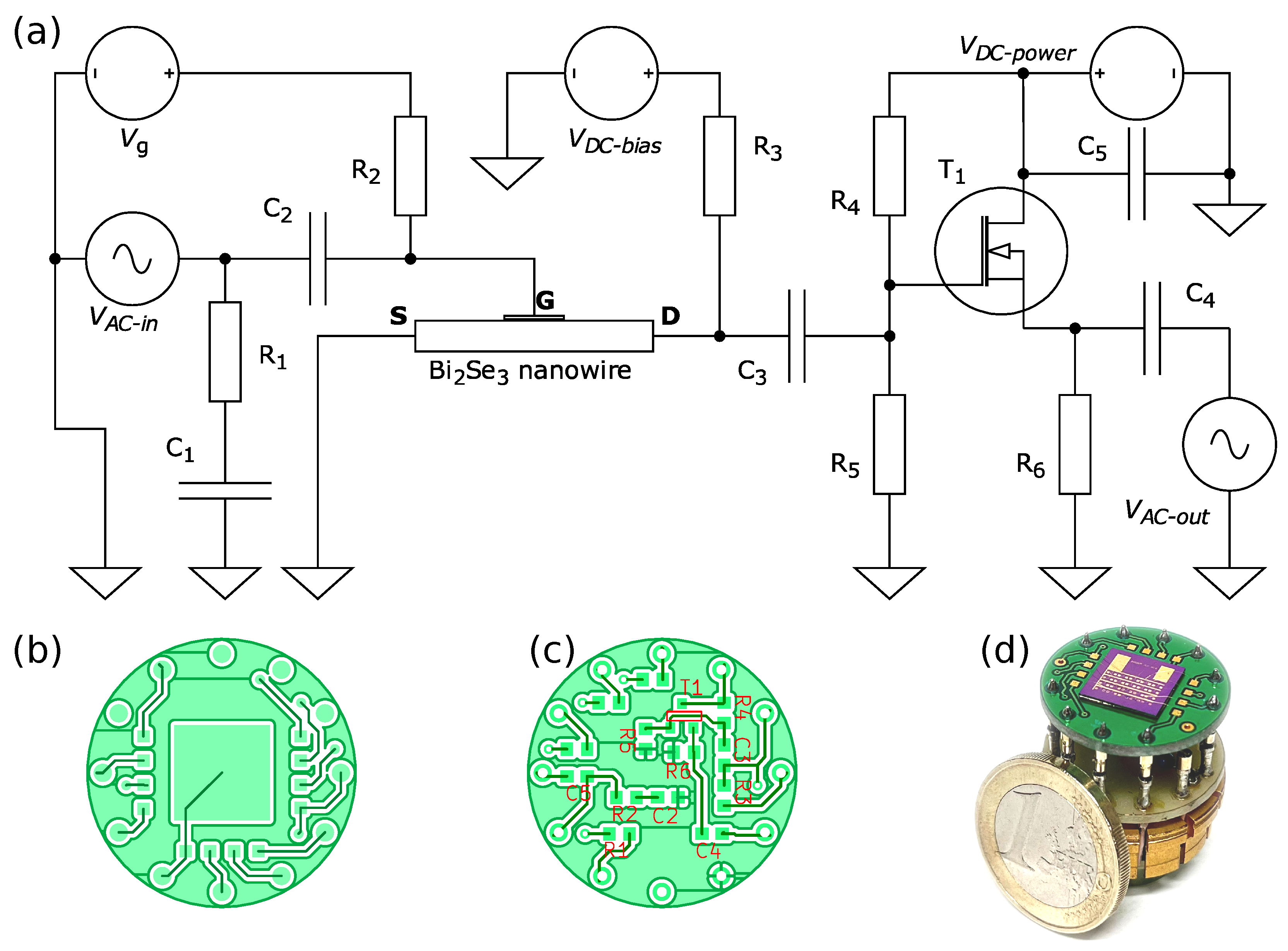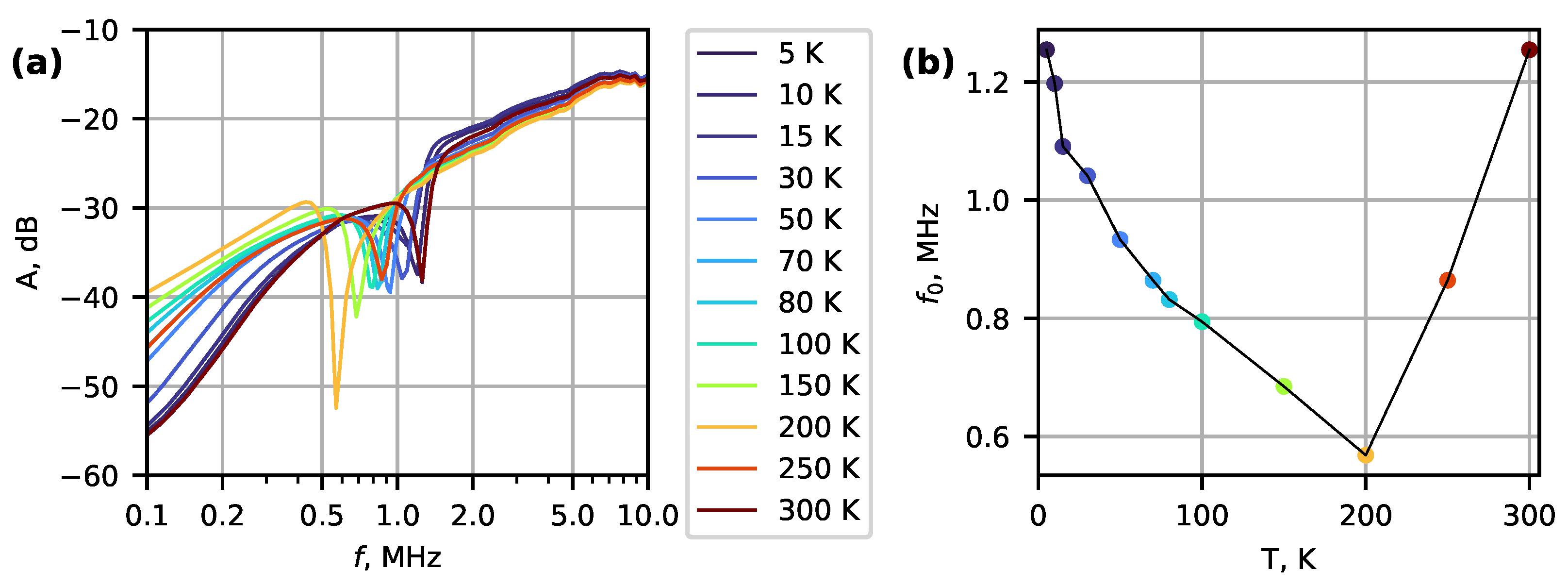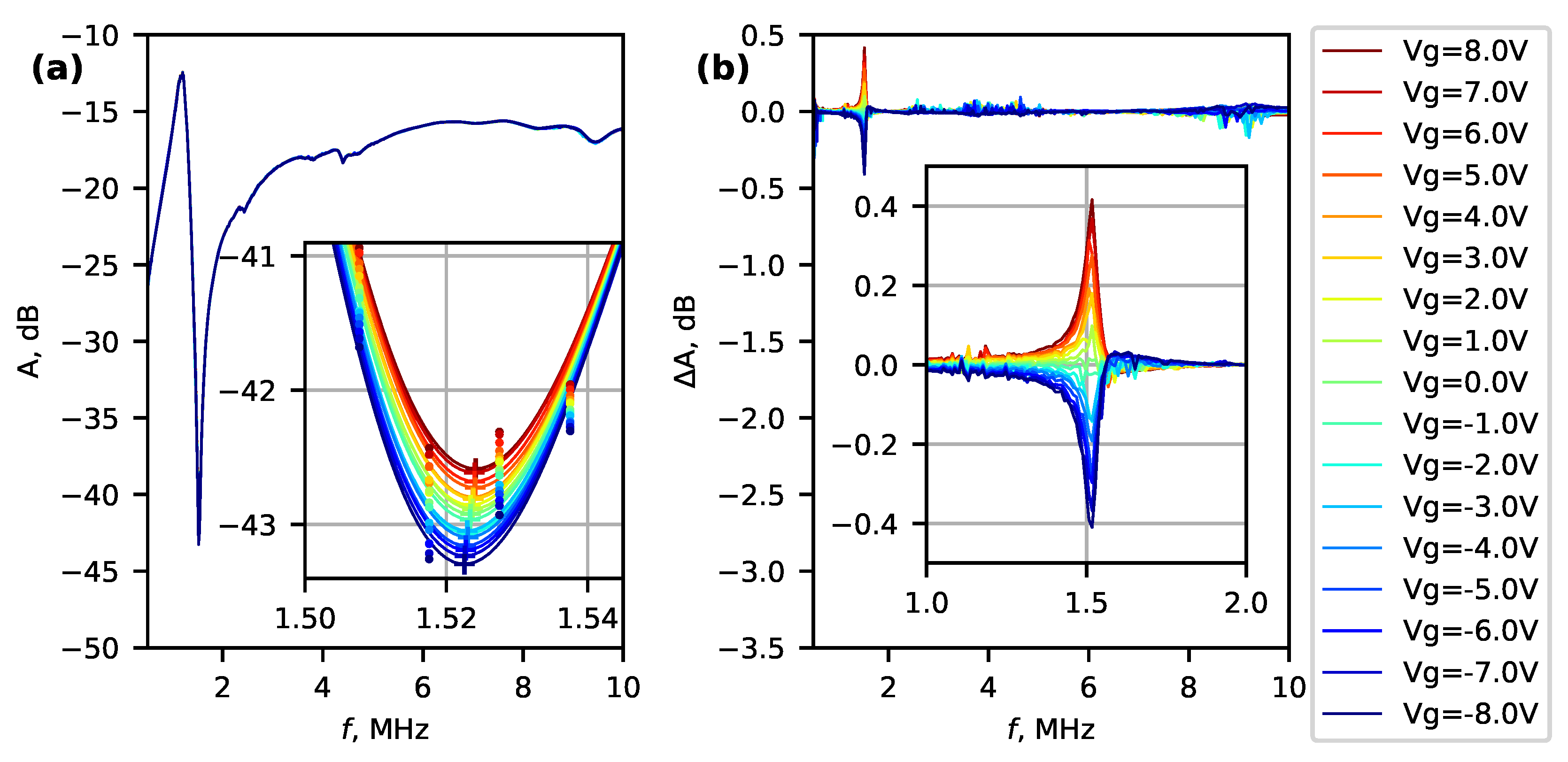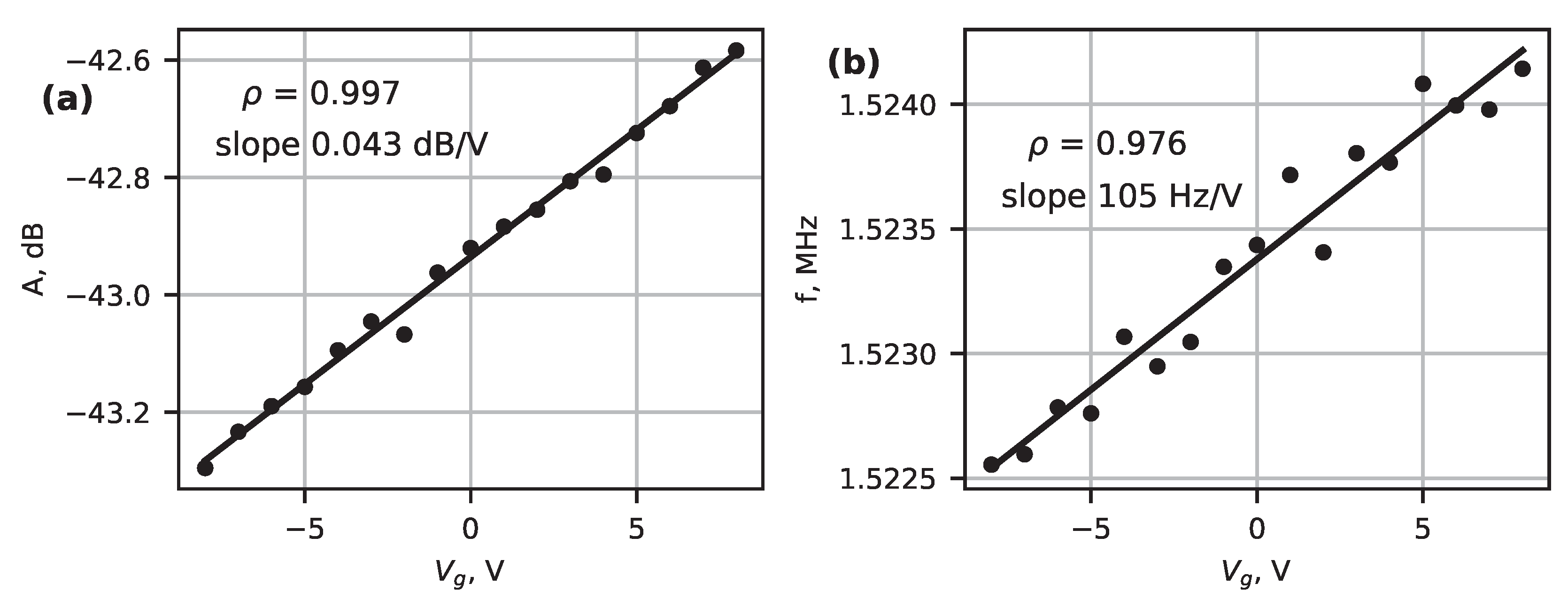Characterization of Mechanical Oscillations in Bismuth Selenide Nanowires at Low Temperatures
Abstract
:1. Introduction
2. Materials and Methods
2.1. Device Fabrication
2.2. Electronic Measurements
- A standard MOSFET as a test three-terminal device to determine if the amplification of the circuit remains consistent at low temperatures;
- A 5 MHz quartz resonator to examine gain and frequency variations in response to lowering the temperature;
- A standard 20 kΩ resistor to check for unwanted resonances in the circuit.
3. Results and Discussion
4. Conclusions
Author Contributions
Funding
Data Availability Statement
Conflicts of Interest
References
- Xu, B.; Zhang, P.; Zhu, J.; Liu, Z.; Eichler, A.; Zheng, X.Q.; Lee, J.; Dash, A.; More, S.; Wu, S.; et al. Nanomechanical Resonators: Toward Atomic Scale. ACS Nano 2022, 16, 15545–15585. [Google Scholar] [CrossRef] [PubMed]
- Loh, O.Y.; Espinosa, H.D. Nanoelectromechanical contact switches. Nat. Nanotechnol. 2012, 7, 283–295. [Google Scholar] [CrossRef]
- Jasulaneca, L.; Kosmaca, J.; Meija, R.; Andzane, J.; Erts, D. Review: Electrostatically actuated nanobeam-based nanoelectromechanical switches—Materials solutions and operational conditions. Beilstein J. Nanotechnol. 2018, 9, 271–300. [Google Scholar] [CrossRef]
- Wang, L.; Zhang, P.; Liu, Z.; Wang, Z.; Yang, R. On-chip mechanical computing: Status, challenges, and opportunities. Chip 2023, 2, 100038. [Google Scholar] [CrossRef]
- Kozinsky, I.; Postma, H.W.C.; Bargatin, I.; Roukes, M.L. Tuning nonlinearity, dynamic range, and frequency of nanomechanical resonators. Appl. Phys. Lett. 2006, 88, 253101. [Google Scholar] [CrossRef]
- Ye, F.; Lee, J.; Feng, P.X.L. Electrothermally Tunable Graphene Resonators Operating at Very High Temperature up to 1200 K. Nano Lett. 2018, 18, 1678–1685. [Google Scholar] [CrossRef] [PubMed]
- Sahafi, P.; Rose, W.; Jordan, A.; Yager, B.; Piscitelli, M.; Budakian, R. Ultralow Dissipation Patterned Silicon Nanowire Arrays for Scanning Probe Microscopy. Nano Lett. 2020, 20, 218–223. [Google Scholar] [CrossRef]
- Dominguez-Medina, S.; Fostner, S.; Defoort, M.; Sansa, M.; Stark, A.K.; Halim, M.A.; Vernhes, E.; Gely, M.; Jourdan, G.; Alava, T.; et al. Neutral mass spectrometry of virus capsids above 100 megadaltons with nanomechanical resonators. Science 2018, 362, 918–922. [Google Scholar] [CrossRef] [PubMed]
- Kosmaca, J.; Jasulaneca, L.; Meija, R.; Andzane, J.; Romanova, M.; Kunakova, G.; Erts, D. Young’s modulus and indirect morphological analysis of Bi2Se3 nanoribbons by resonance measurements. Nanotechnology 2017, 28, 325701. [Google Scholar] [CrossRef]
- Jasulaneca, L.; Meija, R.; Livshits, A.I.; Prikulis, J.; Biswas, S.; Holmes, J.D.; Erts, D. Determination of Young’s modulus of Sb2S3 nanowires by in situ resonance and bending methods. Beilstein J. Nanotechnol. 2016, 7, 278–283. [Google Scholar] [CrossRef] [PubMed]
- Chiout, A.; Brochard-Richard, C.; Marty, L.; Bendiab, N.; Zhao, M.Q.; Johnson, A.T.C.; Oehler, F.; Ouerghi, A.; Chaste, J. Extreme mechanical tunability in suspended MoS2 resonator controlled by Joule heating. npj 2D Mater. Appl. 2023, 7, 20. [Google Scholar] [CrossRef]
- Kim, M.; Kim, J.; Hou, Y.; Yu, D.; Doh, Y.J.; Kim, B.; Kim, K.W.; Suh, J. Nanomechanical characterization of quantum interference in a topological insulator nanowire. Nat. Commun. 2019, 10, 4522. [Google Scholar] [CrossRef]
- Xu, Y.; Chen, C.; Deshpande, V.V.; DiRenno, F.A.; Gondarenko, A.; Heinz, D.B.; Liu, S.; Kim, P.; Hone, J. Radio frequency electrical transduction of graphene mechanical resonators. Appl. Phys. Lett. 2010, 97, 243111. [Google Scholar] [CrossRef]
- Witkamp, B.; Poot, M.; van der Zant, H.S.J. Bending-Mode Vibration of a Suspended Nanotube Resonator. Nano Lett. 2006, 6, 2904–2908. [Google Scholar] [CrossRef]
- Belov, M.; Quitoriano, N.J.; Sharma, S.; Hiebert, W.K.; Kamins, T.I.; Evoy, S. Mechanical resonance of clamped silicon nanowires measured by optical interferometry. J. Appl. Phys. 2008, 103, 074304. [Google Scholar] [CrossRef]
- Södergren, L.; Olausson, P.; Lind, E. Low-Temperature Characteristics of Nanowire Network Demultiplexer for Qubit Biasing. Nano Lett. 2022, 22, 3884–3888. [Google Scholar] [CrossRef] [PubMed]
- Poncharal, P.; Wang, Z.L.; Ugarte, D.; de Heer, W.A. Electrostatic deflections and electromechanical resonances of carbon nanotubes. Science 1999, 283, 1513–1516. [Google Scholar] [CrossRef]
- Vogl, L.M.; Schweizer, P.; Denninger, P.; Richter, G.; Spiecker, E. Sensing Capabilities of Single Nanowires Studied with Correlative In Situ Light and Electron Microscopy. ACS Nano 2022, 16, 18110–18118. [Google Scholar] [CrossRef] [PubMed]
- Nichol, J.M.; Hemesath, E.R.; Lauhon, L.J.; Budakian, R. Nanomechanical detection of nuclear magnetic resonance using a silicon nanowire oscillator. Phys. Rev. B 2012, 85, 054414. [Google Scholar] [CrossRef]
- Castellanos-Gomez, A.; Singh, V.; van der Zant, H.S.J.; Steele, G.A. Mechanics of freely-suspended ultrathin layered materials. Ann. Phys. 2015, 527, 27–44. [Google Scholar] [CrossRef]
- Sazonova, V.; Yaish, Y.; Üstünel, H.; Roundy, D.; Arias, T.A.; McEuen, P.L. A tunable carbon nanotube electromechanical oscillator. Nature 2004, 431, 284–287. [Google Scholar] [CrossRef]
- Lassagne, B.; Tarakanov, Y.; Kinaret, J.; Garcia-Sanchez, D.; Bachtold, A. Coupling Mechanics to Charge Transport in Carbon Nanotube Mechanical Resonators. Science 2009, 325, 1107–1110. [Google Scholar] [CrossRef] [PubMed]
- Manzeli, S.; Dumcenco, D.; Migliato Marega, G.; Kis, A. Self-sensing, tunable monolayer MoS2 nanoelectromechanical resonators. Nat. Commun. 2019, 10, 4831. [Google Scholar] [CrossRef]
- Li, C.H.; van ‘t Erve, O.M.J.; Robinson, J.T.; Liu, Y.; Li, L.; Jonker, B.T. Electrical detection of charge-current-induced spin polarization due to spin-momentum locking in Bi2Se3. Nat. Nanotechnol. 2014, 9, 218–224. [Google Scholar] [CrossRef]
- Lu, Q.; Li, P.; Guo, Z.; Dong, G.; Peng, B.; Zha, X.; Min, T.; Zhou, Z.; Liu, M. Giant tunable spin Hall angle in sputtered Bi2Se3 controlled by an electric field. Nat. Commun. 2022, 13, 1650. [Google Scholar] [CrossRef] [PubMed]
- Kunakova, G.; Galletti, L.; Charpentier, S.; Andzane, J.; Erts, D.; Léonard, F.; Spataru, C.; Bauch, T.; Lombardi, F. Bulk-free topological insulator Bi2Se3 nanoribbons with magnetotransport signatures of Dirac surface states. Nanoscale 2018, 10, 19595–19602. [Google Scholar] [CrossRef]
- Jasulaneca, L.; Meija, R.; Kauranens, E.; Sondors, R.; Andzane, J.; Rimsa, R.; Mozolevskis, G.; Erts, D. Cryogenic nanoelectromechanical switch enabled by Bi2Se3 nanoribbons. Mater. Sci. Eng. B 2022, 275, 115510. [Google Scholar] [CrossRef]
- Meija, R.; Livshits, A.I.; Kosmaca, J.; Jasulaneca, L.; Andzane, J.; Biswas, S.; Holmes, J.D.; Erts, D. Resonance assisted jump-in voltage reduction for electrostatically actuated nanobeam-based gateless NEM switches. Nanotechnology 2019, 30, 385203. [Google Scholar] [CrossRef]
- Chen, C.; Deshpande, V.V.; Koshino, M.; Lee, S.; Gondarenko, A.; MacDonald, A.H.; Kim, P.; Hone, J. Modulation of mechanical resonance by chemical potential oscillation in graphene. Nat. Phys. 2016, 12, 240–244. [Google Scholar] [CrossRef]
- Sondors, R.; Kunakova, G.; Jasulaneca, L.; Andzane, J.; Kauranens, E.; Bechelany, M.; Erts, D. High-Yield Growth and Tunable Morphology of Bi2Se3 Nanoribbons Synthesized on Thermally Dewetted Au. Nanomaterials 2021, 11, 2020. [Google Scholar] [CrossRef] [PubMed]
- Gui, H.; Chen, R.; Niu, J.; Zhang, Z.; Tolbert, L.M.; Wang, F.F.; Blalock, B.J.; Costinett, D.; Choi, B.B. Review of Power Electronics Components at Cryogenic Temperatures. IEEE Trans. Power Electron. 2020, 35, 5144–5156. [Google Scholar] [CrossRef] [PubMed]
- Luo, C.; Li, Z.; Lu, T.T.; Xu, J.; Guo, G.P. MOSFET characterization and modeling at cryogenic temperatures. Cryogenics 2019, 98, 12–17. [Google Scholar] [CrossRef]
- Mathew, J.P.; Bhushan, A.; Deshmukh, M.M. Tension mediated nonlinear coupling between orthogonal mechanical modes of nanowire resonators. Solid State Commun. 2018, 282, 17–20. [Google Scholar] [CrossRef]
- Solanki, H.S.; Sengupta, S.; Dhara, S.; Singh, V.; Patil, S.; Dhall, R.; Parpia, J.; Bhattacharya, A.; Deshmukh, M.M. Tuning mechanical modes and influence of charge screening in nanowire resonators. Phys. Rev. B 2010, 81, 115459. [Google Scholar] [CrossRef]
- Yu, L.; Pajouhi, H.; Nelis, M.R.; Rhoads, J.F.; Mohammadi, S. Tunable, Dual-Gate, Silicon-on-Insulator (SOI) Nanoelectromechanical Resonators. IEEE Trans. Nanotechnol. 2012, 11, 1093–1099. [Google Scholar] [CrossRef]
- Bartsch, S.T.; Rusu, A.; Ionescu, A.M. Phase-locked loop based on nanoelectromechanical resonant-body field effect transistor. Appl. Phys. Lett. 2012, 101, 153116. [Google Scholar] [CrossRef]
- Cleland, A.N. Foundations of Nanomechanics; Advanced Texts in Physics; Springer: Berlin/Heidelberg, Germany, 2003. [Google Scholar] [CrossRef]
- Yibibulla, T.; Jiang, Y.; Wang, S.; Huang, H. Size- and temperature-dependent Young’s modulus of SiC nanowires determined by a laser-Doppler vibration measurement. Appl. Phys. Lett. 2021, 118, 043103. [Google Scholar] [CrossRef]
- Ma, L.; Yibibulla, T.; Jiang, Y.; Mead, J.L.; Lu, M.; Wang, S.; Huang, H. Temperature and size dependent mechanical properties of vapor synthesized zinc tungstate nanowires. Phys. E Low-Dimens. Syst. Nanostructures 2022, 136, 114990. [Google Scholar] [CrossRef]
- Chen, C.; Rosenblatt, S.; Bolotin, K.I.; Kalb, W.; Kim, P.; Kymissis, I.; Stormer, H.L.; Heinz, T.F.; Hone, J. Performance of monolayer graphene nanomechanical resonators with electrical readout. Nat. Nanotech. 2009, 4, 861–867. [Google Scholar] [CrossRef]
- Arjmandi-Tash, H.; Allain, A.; Han, Z.V.; Bouchiat, V. Large scale integration of CVD-graphene based NEMS with narrow distribution of resonance parameters. 2D Mater. 2017, 4, 025023. [Google Scholar] [CrossRef]
- Montague, J.R.; Bertness, K.A.; Sanford, N.A.; Bright, V.M.; Rogers, C.T. Temperature-dependent mechanical-resonance frequencies and damping in ensembles of gallium nitride nanowires. Appl. Phys. Lett. 2012, 101, 173101. [Google Scholar] [CrossRef]
- Arcamone, J.; Misischi, B.; Serra-Graells, F.; van den Boogaart, M.A.F.; Brugger, J.; Torres, F.; Abadal, G.; Barniol, N.; Perez-Murano, F. A Compact and Low-Power CMOS Circuit for Fully Integrated NEMS Resonators. IEEE Trans. Circuits Syst. II Express Briefs 2007, 54, 377–381. [Google Scholar] [CrossRef]
- Xu, B.; Zhu, J.; Xiao, F.; Jiao, C.; Liang, Y.; Wen, T.; Wu, S.; Zhang, Z.; Lin, L.; Pei, S.; et al. Identifying, Resolving, and Quantifying Anisotropy in ReS2 Nanomechanical Resonators. Small 2023, 19, 2300631. [Google Scholar] [CrossRef] [PubMed]







| Device | m | t, nm | w, nm | Ω | , MHz | , MHz |
|---|---|---|---|---|---|---|
| No. 1 | 7.6 | 224 | 124 | 50 | 1.5 | 9.8 |
| No. 2 | 8.3 | 35 | 266 | 36 | 1.2 | 1.2 |
Disclaimer/Publisher’s Note: The statements, opinions and data contained in all publications are solely those of the individual author(s) and contributor(s) and not of MDPI and/or the editor(s). MDPI and/or the editor(s) disclaim responsibility for any injury to people or property resulting from any ideas, methods, instructions or products referred to in the content. |
© 2023 by the authors. Licensee MDPI, Basel, Switzerland. This article is an open access article distributed under the terms and conditions of the Creative Commons Attribution (CC BY) license (https://creativecommons.org/licenses/by/4.0/).
Share and Cite
Jasulaneca, L.; Poplausks, R.; Prikulis, J.; Dzene, E.; Yager, T.; Erts, D. Characterization of Mechanical Oscillations in Bismuth Selenide Nanowires at Low Temperatures. Micromachines 2023, 14, 1910. https://doi.org/10.3390/mi14101910
Jasulaneca L, Poplausks R, Prikulis J, Dzene E, Yager T, Erts D. Characterization of Mechanical Oscillations in Bismuth Selenide Nanowires at Low Temperatures. Micromachines. 2023; 14(10):1910. https://doi.org/10.3390/mi14101910
Chicago/Turabian StyleJasulaneca, Liga, Raimonds Poplausks, Juris Prikulis, Elza Dzene, Tom Yager, and Donats Erts. 2023. "Characterization of Mechanical Oscillations in Bismuth Selenide Nanowires at Low Temperatures" Micromachines 14, no. 10: 1910. https://doi.org/10.3390/mi14101910
APA StyleJasulaneca, L., Poplausks, R., Prikulis, J., Dzene, E., Yager, T., & Erts, D. (2023). Characterization of Mechanical Oscillations in Bismuth Selenide Nanowires at Low Temperatures. Micromachines, 14(10), 1910. https://doi.org/10.3390/mi14101910






